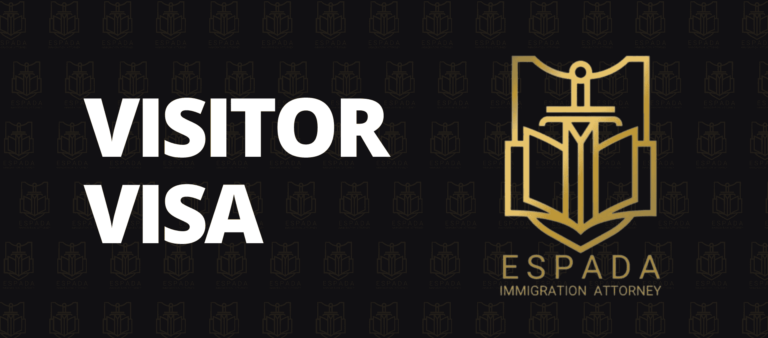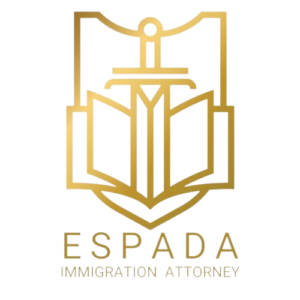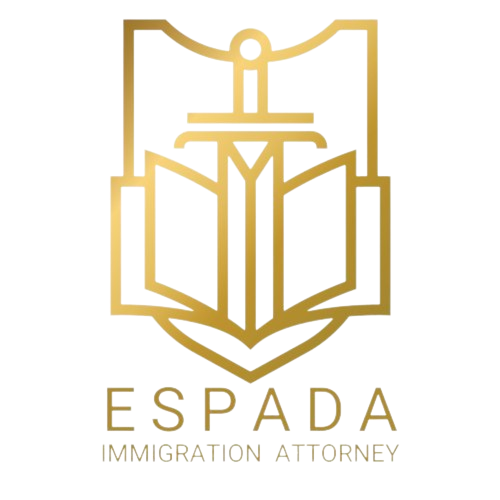Visitor visa : A Comprehensive Guide to the US Visitor Visa

The B visa, commonly referred to as the tourist or visitor visa, is a specialized visa designed for foreign nationals wishing to visit the United States. Individuals visiting for business purposes are categorized as B-1, while those traveling for tourism purposes fall under the B-2 category.
In this guide, I will cover everything you need to know about the visitor visa. If you have any questions, feel free to email me directly at abbas@espadaimmigration.com. My team of U.S. immigration attorneys and I would be delighted to assist you.
Overview:
-
What is a Visitor Visa?
-
What are the Benefits of a Visitor Visa?
-
Who Needs a Visitor Visa?
-
Who is Eligible for a Visitor Visa?
-
Visitor Visa Process
-
What Documents are Required for the Visitor Visa?
-
What are the Fees for a Visitor Visa?
-
Visitor Visa Processing Time
-
Visitor Visa Interview
-
Special Situations
-
Conclusion
1. What is a Visitor Visa?
Visitor visas, also known as B visas, are issued to foreign nationals who wish to travel to the United States. There are two main categories: the B-1 visa for business visitors and the B-2 visa for tourism.
These visas allow individuals to stay in the United States for up to six months. A B-1 visa permits visitors to engage in business-related activities, including, but not limited to:
- Conducting business transactions
- Meeting with associates
- Carrying out research
- Attending conferences
- Negotiating contracts
However, it’s important to note that B-1 visa holders are not permitted to engage in any employment that would provide a direct income in the United States.
For those traveling on a B-2 visa, tourism activities are permitted, including, but not limited to:
- Visiting tourist attractions
- Spending time with family or friends
- Seeking medical treatment
- Participating in social or recreational events
- Competing in amateur events
- Taking non-credit educational courses
If you are unsure about which type of visa is best suited for your needs, Espada Immigration can assist you in determining the most appropriate visa option.
2. What Are the Benefits of a Visitor Visa?
Visitor visas offer a number of benefits, including:
- You do not need an approved visa petition from US Citizenship and Immigration Services (USCIS).
- Applications can be submitted at your nearest US consulate.
- No sponsor is required for this visa.
- A single application can grant permission for multiple visits to the US over an extended period of time, potentially lasting up to 10 years.
- You can receive multiple visitor visas throughout your lifetime.
3. Who Needs a Visitor Visa?
If you are not a US permanent resident or do not hold a valid visa, you may need to apply for a B visa. However, some individuals may be eligible for the Visa Waiver Program (VWP), which allows travel to the US without the need for a visa for short stays.
The VWP is available to citizens of 38 participating countries, including:
- Andorra (1991)
- Australia (1996)
- Austria (1991)
- Belgium (1991)
- Brunei (1993)
- Chile (2014)
- Czech Republic (2008)
- Denmark (1991)
- Estonia (2008)
- Finland (1991)
- France (1989)
- Germany (1989)
- Greece (2010)
- Hungary (2008)
- Iceland (1991)
- Ireland (1995)
- Italy (1989)
- Japan (1988)
- Republic of Korea (2008)
- Latvia (2008)
- Liechtenstein (1991)
- Lithuania (2008)
- Luxembourg (1991)
- Malta (2008)
- Monaco (1991)
- Netherlands (1989)
- New Zealand (1991)
- Norway (1991)
- Portugal (1999)
- San Marino (1991)
- Singapore (1999)
- Slovakia (2008)
- Slovenia (1997)
- Spain (1991)
- Sweden (1989)
- Switzerland (1989)
- Taiwan (2012)
- United Kingdom (1988)
Please note, the VWP is only available for travelers who plan to stay in the United States for less than 90 days and must have a valid Electronic System for Travel Authorization (ESTA) approval.
In addition, citizens of certain countries, like Canada and Bermuda, do not need a visa for stays of less than 180 days.
You are not eligible for a B visa if your purpose of travel is to study, work, perform paid activities, work as a crew member, engage in media work, or seek permanent residency. If your situation falls into one of these categories, please contact Espada Immigration to explore the appropriate visa options for you.
4. Who is eligible for a visitor visa?
To qualify for a visitor visa, applicants must demonstrate the following:
A Valid Reason for Visiting the United States
In order to obtain a visitor visa, you must provide evidence supporting your purpose of travel. The two primary types of visitor visas are the B1 and B2 visas.
- B1 visa is for individuals coming to the U.S. for business purposes, such as completing transactions, consulting with colleagues, conducting research, attending conferences, negotiating contracts, or observing American business practices.
- B2 visa is for those visiting for leisure, to see family or friends, receive medical treatment, participate in social events, engage in amateur competitions, or take part in a non-credit study course.
Espada Immigration can assist you in determining if a visitor visa is the best option for your circumstances.
Consistency with Visa Purpose
For a B visa, you must prove that your activities in the United States will align with the conditions of the visa. Specifically, B1 visa holders are prohibited from engaging in hands-on work or receiving compensation from a U.S. company. However, individuals employed by a foreign company may provide services or receive training in the U.S. while on a B visa.
Domestic Worker B1 Visa (EAD)
Domestic workers, such as housekeepers, gardeners, or caretakers, may be eligible for a B1 visa. Under this visa, the worker can apply for an Employment Authorization Document (EAD). The following requirements must be met:
- The worker must have been employed by their employer for at least one year.
- They must be paid fairly.
- They must return to their home country after the visa expires.
B2 Visa Exceptions
The B2 visa has an exception for those accompanying a partner who is on another nonimmigrant visa. This includes foreign nationals accompanying a partner traveling on a nonimmigrant visa who is not eligible to be a dependent. This can apply to same-sex or common-law partners, as well as extended relatives.
If you have questions about your eligibility for a visitor visa, an immigration lawyer, such as myself or a member of my team, can assist you.
Sufficient Funds for the Stay
Applicants must prove they have enough financial resources to support their stay in the U.S. If an individual is unable to demonstrate independent financial resources, they can show evidence that they will be supported by an employer or relative.
Intent to Return to Home Country
It is essential to demonstrate that you have strong ties to your home country and intend to return once your visit is complete. During your consular interview, you will need to explain your itinerary and plans for returning home after your visit.
5. Visitor Visa Process
Securing a visitor visa involves multiple steps. Although the process may vary depending on the U.S. embassy or consulate you are applying through, here is a general outline of the process:
- Submit Form DS-160
- Upload a Photo
- Pay Visa Fees
- Schedule Your U.S. Tourist Visa Interview
- Prepare Additional Documents
- Attend the Visa Interview
- Arrival in the United States
Complete the DS-160
The DS-160 is the Online Nonimmigrant Visa Application form, required for temporary travel to the United States. You must complete and submit this form online before scheduling your consular interview. After submitting the form, print the confirmation page to bring with you to your interview.
Upload a Photo
When you submit your DS-160 form, you will need to upload a U.S. visa-compliant photo. You can find the full photo requirements on the U.S. embassy or consulate website.
Pay Visa Fees
Before scheduling your interview, you must pay the visa application fee. The specific fee amount will be provided on your local U.S. embassy or consulate website.
Schedule a Visa Interview
Individuals between the ages of 14 and 79 are required to attend an interview with a consular officer. Those under 13 or over 80 are typically not required to undergo an interview, but it is recommended to confirm this with your local consulate. Scheduling the interview is your responsibility, and completing the DS-160 does not automatically schedule your appointment. Due to varying waiting times depending on the location and visa category, it is advisable to apply well in advance.
Prepare Documents
For your interview, you will need the following documents:
- A passport valid for at least six months beyond your intended stay.
- The confirmation page from your completed DS-160 form.
- A receipt for the visa application fee.
- Your visa photo.
- Documents supporting your trip’s purpose.
- Evidence of your ties to your home country.
- Proof of your ability to cover the expenses of your trip.
Attend the Visa Interview
At your visa interview, a consular officer will assess whether to approve your visitor visa application. Fingerprints will be taken during the interview or afterward, depending on the location.
Arrival in the United States
Visitor visas can be issued for up to 10 years, allowing multiple entries during that period. However, the duration of each entry is typically limited to six months, though some may be allowed to stay for up to one year, depending on the nature of their visit.
6. What Documents Are Required for the Visitor Visa?
When attending your consular interview, you may need to present several documents. Below is a general list of the required documentation. Please note that the specific documents you need to provide will depend on your individual circumstances. An immigration lawyer can assist you in determining which documents are necessary for your case.
- Valid Passport
- US Visa Photo
- Form DS-160 confirmation page and code
- Receipt of paid visa fees
- Interview confirmation page
- Proof of financial means
- Evidence of ties to your home country
- Itinerary for your trip
- Letter from a family member, friend, doctor, or for an event
- Social media details
7. What Are the Fees for a Visitor Visa?
- US Tourist Visa Fee: $160
- Visa Issuance Fees: These vary depending on the country
- Other Fees (including photocopying, transportation, etc.): These costs are assessed on a case-by-case basis
8. Visitor Visa Processing Time
The processing time for a visitor visa can vary depending on factors such as the time of year and the consulate handling your case. However, the typical processing time ranges from 2 weeks to 2 months.
9. Visitor Visa Interview
As previously mentioned, most applicants for a B visa are required to undergo an interview with a consular officer. During the interview, you will need to demonstrate that you have a residence in your home country that you do not intend to abandon. You must also show that your visit to the US is for a specific and limited period, and that your purpose is to engage in permissible business or leisure activities. An immigration lawyer can help you prepare for your interview to ensure you meet all necessary requirements.
10. Special Situations
Chinese Nationals
Starting November 2016, all Chinese nationals holding a 10-year visitor visa must register with the Electronic Visa Update System (EVUS) before entering the United States. Chinese nationals seeking more information on this requirement can contact an immigration lawyer for further assistance.Canadian and Mexican Nationals
Under the NAFTA Treaty, citizens of Canada and Mexico can engage in certain activities that are classified as “business” for citizens of other countries. Provided the occupation meets the requirements for a visitor visa, Canadian and Mexican businesspeople participating in this program may receive an expense allotment or reimbursement. For more information about this program, feel free to reach out or consult with an immigration lawyer.
11. Conclusion
The B visa (commonly referred to as the visitor visa) is designed for foreign nationals who wish to visit the United States. You should now have a clear understanding of the key aspects of the B visa, including the two main categories (B1 and B2), the necessary requirements, and the application process.
If you have any questions regarding the information covered in this guide or the B visa in general, don’t hesitate to email me directly at abbas@espadaimmigration.com. I am very responsive via email and will be happy to assist you.
Why Choose Us
Choosing the right immigration lawyer can make all the difference in achieving your U.S. immigration goals. At Espada Immigration Lawyer, we are dedicated to providing exceptional legal guidance and personalized support through every step of the process. Our team combines specialized expertise, transparency, and an unwavering commitment to client success, making us a trusted partner for all your immigration needs.
- Specialized Expertise
- Personalized Approach
- Transparent Guidance
- Client-Centered Commitment

DISCLAIMER: This article is provided for general informational purposes only and does not constitute legal advice. The information herein should not be interpreted as formal legal counsel nor does it establish an attorney-client relationship. This article is neither intended as a solicitation for legal services nor as a substitute for individual legal advice. For specific legal guidance, please consult an attorney in your jurisdiction. Actions based on information in this article are taken at your own risk, and I disclaim any liability for such actions. Please note that information may have changed since publication and may no longer be current. This article does not offer guarantees, warranties, or predictions regarding the outcome of any legal matters. Each case is unique, and results will depend on individual facts and legal issues. Thank you.
ATTORNEY ADVERTISING: Any invitation to contact our law firm on this website and related pages constitutes attorney advertising.
